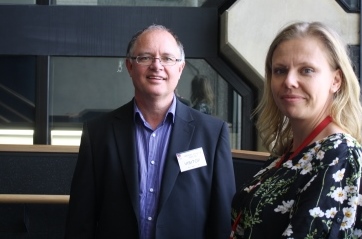Calculating the cost of an overload of iron

Calculating the cost of an overload of iron
Haemochromatosis is not part of our everyday vocabulary, yet it's one of the most common genetic disorders among people of European descent, and if left untreated its health impacts are debilitating.
Haemochromatosis is not part of our everyday vocabulary, yet it's one of the most common genetic disorders among people of European descent, and if left untreated its health impacts are debilitating.
Menzies Research Institute Tasmania PhD student Barbara de Graaff is researching the cost of haemochromatosis, which affects one in 200 people of European descent and is characterised by an overload of iron in the body. Her research will help to inform whether, given how common the condition is, a screening program for the population would be cost effective.
When a person has haemochromatosis, excess iron is stored in the liver, heart and pancreas. If left untreated it can lead to arthritis, fatigue, Type 2 diabetes, impotence, liver disease and heart disease. Haemochromatosis is caused by an inherited gene mutation.
Ms de Graaff's task is complicated by the fact many people with the condition don't know they have it - the symptoms are fairly common and are therefore easily attributed to other causes.
"What we are asking is that people who know they have the condition go online and fill out a web-based survey and keep a diary to answer questions about things such as their medical costs, number of medical appointments and absenteeism and productivity loss caused by the condition," Ms de Graaff said. Information provided by participants will be completely confidential.
As is common, Hobart man Jon Hortle (pictured above with Barbara de Graaff) had the symptoms of haemochromatosis for many years before being diagnosed in his mid-40s. After years of missed diagnosis, a new GP pieced together his symptoms and checked back over years of blood tests. These tests had consistently shown very high levels of iron, but no diagnosis had been made.
"I had been fatigued, had arthritis, dry eyes and eventually was so rundown I got pneumonia," Mr Hortle said. "It was a long path to finding out what I had, but in the end all I needed for a diagnosis was a quick genetic test.''
Haemochromatosis is more common in men. Treatment is straightforward, consisting of regular blood donations to reduce iron stores in the body.
To take part in the survey go to: https://surveys.utas.edu.au/index.php/853154/lang-en or to the website of Haemochromatosis Australia and click on the link 'Survey: Cost of Haemochromatosis': http://haemochromatosis.org.au/
For more information, including to arrange an interview with Barbara de Graaff or Jon Hortle, contact Miranda Harman, Marketing and Communications Manager, Menzies Research Institute Tasmania. Menzies is an Institute of the University of Tasmania.
Ph: 03 6226-7751
Email: Miranda.harman@utas.edu.au, www.menzies.utas.edu.au
Contact:
Phone:
Email: